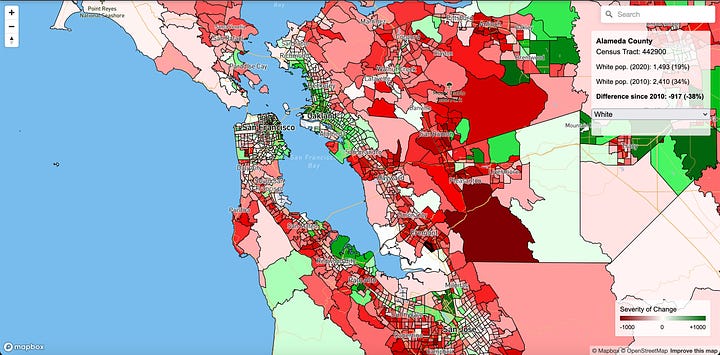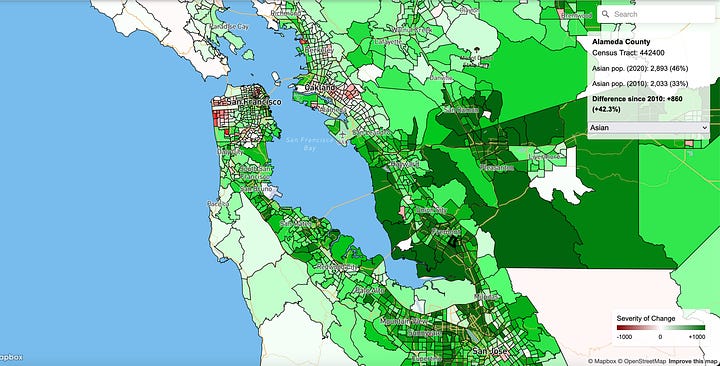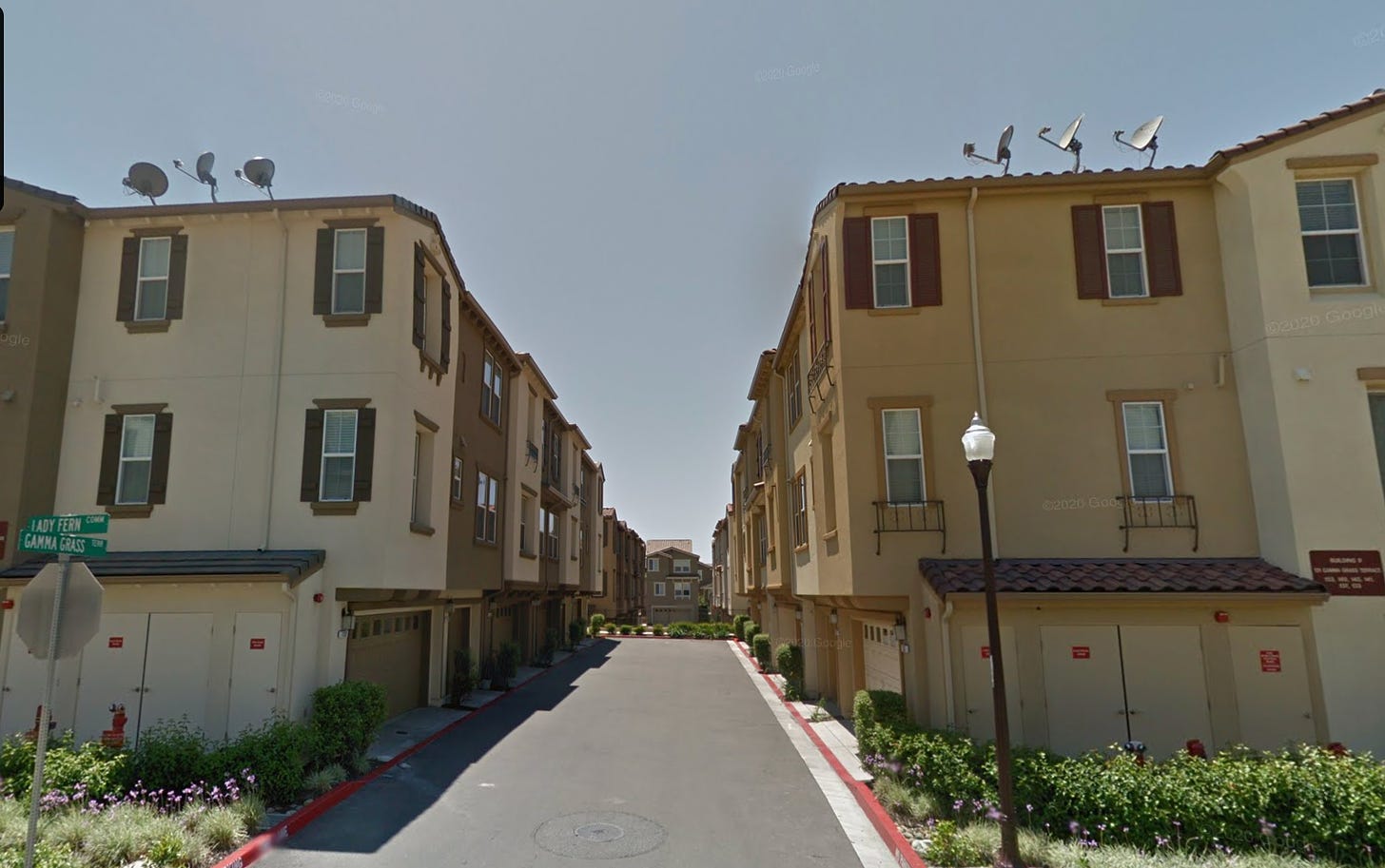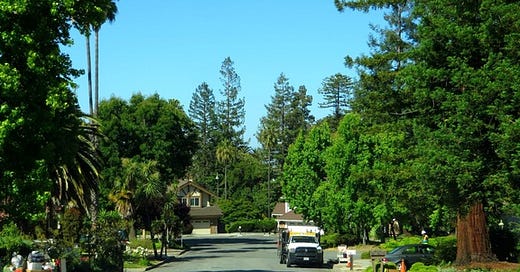My girlfriend is from Fremont, California and during my college days Fremont acted as an intermediary between Santa Cruz and Berkeley where my home was. Initially, I thought Fremont was a suburban nightmare of endless parking lots, horrible public transit, very few interesting amenities, non-existent walkability and cookie-cutter houses. But over time I began to like this place, its ethnic diversity, its incredible food. I even began to enjoy how simplier its right vs. left politics was compared to convulted intra-left fighting back home. I hate to say it but I think my prolonged time in Fremont turned me into a bit of a suburbanite.
Fremont represents the Bay Area of tomorrow. It’s a suburban “city” but with bigger, absurdly expensive $2 million single-family homes and dense townhomes. There is no greater concentration of Teslas and people driving around on auto-pilot anywhere in the country, since the Tesla factory is in Fremont. Since 2020, Asians eclipsed whites as the largest racial group in the Bay Area, but the Asian population has comprised the majority of Fremont since the late 1990s, and in the last twenty years, skyrocketed to a super majority.
The gentrification of Oakland and San Francisco, and their growing white populations has often erroneously been abstracted onto broader Bay Area trends, but in reality, they’re the exception, not the rule. The white population, outside of Oakland and S.F., has been replaced by an emerging Asian upper and middle class in the region’s most well-resourced and higher-income suburbs.


It’s hard to distinguish how much of this white population decline is preference vs. affordability (it’s probably both), but you can see in these 10-year census maps how the only areas becoming whiter in the Bay, are formerly redlined, Black and Hispanic neighborhoods in the urban core. When my girlfriend’s family moved to Fremont in 2000, her neighborhood was equally white and Asian. Now, the white population barely exceeds 10% while Indian and Chinese families now represent the majority.
Politically, Fremont votes Democrat at all levels of government but exhibits socially conservative trends. The Asian-majority voting block votes are like the old white one they replaced but with a few points of contention. When it comes to issues of caste — a rampant discrimination issue in Silicon Valley among the Indian community — politics can get intense. Socially conservative and religious Chinese parents fought against a sexual education curriculum proposed for Fremont Unified, which was supported by socially liberal white parents. On social issues like homelessness, a similar showdown happened in the Niles district when a parking lot that was proposed for temporary RV housing became a similar, covert conservative Chinese vs. liberal white issue. Of course there was plenty of racial mix-ups on both sides of these issues, but in my observations these are the general trends.
San Francisco media talks a lot about the right-ward shift of S.F. politics, but I think it’s mostly San Francisco becoming more of an Asian-majority city. The politics San Francisco is headed towards — more law enforcement, anti-homeless encampments, business-friendly, aggressive test-taking educational policies — are already the norm south of its Daly City border in Asian-majority suburbs like Fremont. I think this is hitting San Francisco a bit late because the gentrification of San Francisco was done not by true Silicon Valley workers, but rather by a lot of finance people rebranding as tech people. Calling yourself a founder and having an app on a toaster doesn’t inherently make you tech. Half the Patagonia-wearers in the Mission District probably couldn’t write much code, but could give killer pitches to funders and were avid Steve Jobs biography readers.
No, it wasn’t until I arrived in Fremont that I discovered what a true software engineer’s bedroom community looked like. The Los Altos - Palo Alto core is where the CEOs and the super-rich live, but the everyday software engineer, developer, IT specialist or data scientist, with a family, making around $100,000 - $250,000, typically lives in Fremont. Lots of Teslas but very few Zuckerberg clones walking around like they do in the Mission in San Francisco. Instead, it’s Indian or Pakistani dads driving their daughters in Teslas to afterschool tutoring or getting mochi at the Pacific Commons shopping center.
My girlfriend’s neighborhood is quite diverse, despite the all-encompassing designation of Asian. Her single-family block is split between Chinese and Indian, with older whites scattered in-between. The 1970s-era houses get lit up for Christmas and Halloween but are twice as bright for Diwali, the Hindu light festival. Kids play in the streets and teenagers work on their cars in the driveway. The older white homeowners throw estate sales to give away all their possessions accumulated by their now-grown children who live in Oakland.
Two H1-B workers / students who recently moved in are from Nigeria and catch an AC Transit bus to their school or work every morning. I’ve noticed that the new demographic making their way into Silicon Valley are Africans. When I first walked by these African tech workers waiting for their shuttle and gave them the nod, they didn’t nod back. Just stared and looked away a bit clueless. Being a neighborhood of immigrants and foreign workers, every other car has a “Student Driver” tag on it, which just as often refers to a teenager as it does a 50-year-old.
Outside the single-family subdivision, one side is a collection of older rental townhomes with families of lower and middle incomes. Many of these families are a mix of Desi / South Asian, East Asian or Middle Eastern, according to Census data. Some of these homes house refugees from Syria or Afghanistan and work in retail jobs at the big box stores around town. Often overlooked, these non-tech families in rental apartments do a lot of the Uber driving, delivery, retail and service jobs that keep Fremont running. Or they do the tech jobs that aren’t typical coding such as IT, teaching, or blue-collar work at tech offices. The other side of the subdivision is a strip mall, re-purposed for afterschool tutoring, Asian grocery stores and some of the best restaurants and bakeries I’ve ever had. The food of Fremont and its Asian / Suburban fusion warrants its own article, but the delicious Afghan food of North Fremont is my favorite.
What makes me envy Fremont the most is the presence of families. I spent some time walking around the Warm Springs suburban parks late at night and I was astounded by the huge gathering of families barbequing and the swarm of little children playing around. There are lots of babies and kids in Fremont, as well as teenagers who park at parking lots located at shopping centers, park grounds and empty office parks (because suburban kids have nothing else to do but park). Walking around the shopping center or Milpitas mall, its often split between huge families eating, swarms of kids and teenagers drinking their boba drinks, or seniors conversing.
There’s nothing like this back home in Berkeley. Berkeley is a donut of retiree homeowners and a donut-hole district for college kids in its center. Berkeley’s parks have no children swarming them like Fremont’s. Every other house in Berkeley is inhabited by someone elderly with half the bedrooms empty, and our school district is closing schools because ever fewer children live in the city to enroll. Our refusal to build housing for a half-century has made the town inhospitable and unaffordable to the next generation of families and it’s even worse in San Francisco. S.F. has become a great place for homeowners who bought houses decades ago, one-bedroom dwellers with capped rent, or rich people, but not for families. S.F.’s Under-19 population is just 15%. 19 and Unders make up just 17% of my Berkeley neighborhood, compared to Fremont’s citywide average of 24% and my girlfriend’s neighborhood of 28%.
Fremont is peaceful and quiet, and that’s a big selling point. My Chinese friend working here on a visa, who is also a Fremonter, once explained that the appeal of Fremont to the Asian families moving there is that it’s quiet, safe and the American Dream. Fremont has a vibrant commercial sector which many suburbs can’t claim. There’s very little traffic on the street so driving is physically more pleasant than driving in a congested city.
Of course it’s appealing that there’s little crime. I spent the Fourth of July not having my house shaken by illegal fireworks or blaring engines from street racers like I experienced growing up in Oakland. Even my pretty Berkeley neighborhood experiences higher rates of littering and dumping that isn’t present in my part of Fremont. At one-point I started realizing how much I enjoyed zipping up to the city on BART, only to go home to Fremont and leave the noise of the city behind. I honestly think as an urbanite, I just was enjoying the suburbs to the fullest extent for the first time.
— The Downsides —
But there are unfortunate truths about Fremont that often get overlooked. The average Fremonter reads about the crime in Oakland or sees the shanty towns in West Oakland and San Francisco and they think that’s not their city’s problem. But this severe poverty does exist in Fremont, it’s just that the average Fremonter is ignorant of their own city and wishes not to see it. Fremont’s a big place and they don’t experience much of it beyond their windshield.
The city has 1,000 homeless people on paper, but it’s an undercount because the vast geography makes it hard to cover. Encampment enforcement is strict in Fremont so the homeless often self-select in discreteness. In my conversations with homeless folks at Safeway, the unsheltered homeless in Fremont view the city as a refuge from crime they’ve experienced at encampments in Oakland and S.F. (A little reminder that homeless people are disproportionately the victims of crime, not the perpetrators.) One South Fremont encampment dweller explained to me that they keep low profiles, have small encampments, minimize their trash, and evict people who use drugs or exhibit anti-social traits. They don’t get much in the way of support from the local city government, however that tends to sweep them indiscriminately.
At night, in the vast office parks and barren parking lots near 880, or the parking lots of nature reserves, many working families and people sleep in their vans or sedans. The few people in this town who are aware they exist are the occasional security guards, and rich, young Chinese car enthusiasts who accidentally run into them during one of their meetups in an office park parking lot.
Encampments closer to the out-of-sight, former industrial zones tend to be where homeless people who can’t or won’t be less discrete live. The Irvington district and the Thornton area are where a lot of homeless services are provided and also have a cluster of unhoused people. These neighborhoods were one of the few, not hardcore expensive districts where people in poverty could find an apartment or where subsidized housing was built. These were once places where many Latino families, Southeast Asian, and Afghan families lived, but they’ve been priced out — either to the streets or out of the Bay Area — in the last 30 years.
Walking closer to the 880 freeway communities and light industrial areas showed me the poor side of this Asian Suburbia. Regardless of race, if you’re low income you probably can’t live in Fremont, but there are pockets of communities who through filtered rents and crowded households make their home in Fremont. Immobile “Trailer parks” which are some of the last affordable market housing options predominate, as well as tiny bungalows housing multiple families near loud, awful highways. A lot of elderly Chinese ladies who can’t afford a car ride the bus to this part of town with their grandkids. These communities are ravaged by horrible smells from the Milpitas trash dump, their houses shake from the trucks en route to the warehouses, the streets are very dangerous to cross, and there’s a non-stop groan of car traffic from surface streets feeding into the freeway.
I made the mistake of attempting to walk through these communities and it was one of the most unpleasant, on-foot experiences of my life. Fremont taught me how to drive and cease walking anywhere or expect even bare minimum urban planning. Fremont tries to market itself to young professionals with that fake “new urbanism” downtown gimmick, but “Downtown Fremont” (I thought it was a joke at first) is 50% parking lots, 50% 4-story apartments with half-vacant ground floor commercial, and is 100% dead at all hours of the day. The northern BART station is some weird dystopian 1970s medical-center-oriented development where most of the land around it is empty parking stalls and no housing. The southern BART station, Warm Springs, is trying the new urbanism thing of higher-end modern apartments, but it fails at urbanism because it’s completely un-walkable. It took 45 minutes to an hour to get from the BART station to Safeway with the sound of cars going 50 MPH on a barren sidewalk, beating out my noise-canceling earbuds.
Too many cities think they can create vibrant communities because they zone for dense housing and all their new urbanism just becomes high-density sprawl, which isi how I describe Fremont’s growth. Fremont streets are too wide and there are no grocery stores nearby so all these “new urbanist” residents just drive. They could take the bus to the grocery stores, but the bus runs every hour in Fremont and that’s considered the high-frequency bus. Bike lanes are average in quality, the ample space makes it safer to bike but the city is still too cowardly to protect these lanes with concrete walls.
To address a lack of family housing in the city, the new developments in Fremont are these unusual higher-density townhomes that are oriented toward families. These townhomes are sometimes so densely packed together that they create these weird caverns between blocks. This approach to density gives such little open space compared to the old-fashioned approach of internal courtyards. These dense townhomes are also common in Milpitas, which is essentially Southern Fremont, and house a lot of multi-generational, more lower middle-class families in a compact footprint. We can’t build anything like these in the Bay Area’s urban core because the lots developers buy are much smaller. But with the poor open space standards, I’m not sure I want them even built. They blow a lot of land and build way fewer dwellings than a mid-rise could.

I used to think that public transit in most U.S. cities is a lifeline service for people too poor to own a car, but in Fremont, I don’t think it makes any sense for the poor to ride transit. I took the bus from my girlfriend’s house to a popular shopping center and it took 2 hours and two transfers. When my girlfriend drove me to the shopping center, it took 14 minutes. I can normally handle a transit ride taking double as long as driving, my standards are low. But I can’t handle 16 times the slowdown so I had to get my driver’s license.
Outside urban planning and housing affordability, suburbia has a few other downsides. While a quiet, non-changing suburb is nice for a few days, it gets rather isolating. People live in my girlfriend’s neighborhood for years, if not decades, and don’t talk to each other. A lot of these nice neighbors I mentioned earlier are also just strangers smiling at each other like they would any other stranger. They don’t know who you are. Their properties are also geared up with all kinds of obnoxious security systems even though crime in the area is non-existent. In contrast, I know most of my neighbors who live in my apartment complex, and even the elderly ones are not anywhere as paranoid as some people in Fremont can be. My neighbors do make efforts to introduce themselves when you walk by them.
There was a lot to like about Fremont and suburbia in general. I liked the diversity of cultures which filled my belly with some of the finest cuisine in the world. The presence of families and children gave me hope for the future. But the downsides of suburbia get sick to me after a while. I get sick of driving everywhere; the thrill wears off after doing it just to pop to the store. I get sick of dodging lunatic drivers on the freeway. It gets depressing never being able to interact with people unless I drive somewhere with the intent to mingle. Eventually, you just run out of things to do that aren’t eating at the mall.
Suburbs are good and I’m pro-suburbs. I have no desire to live in a densely packed, urban city center. I’m fine spending an hour on the train commuting, but I’m not fine spending an hour driving. I’m not fine getting in a car just to get groceries. It would be nice if I could walk to the train station or take a frequent bus there. A suburb isn’t quiet because the street only has single-family homes — go ask the lower income residents near 880 to confirm that — rather the street’s quiet because the cul-de-sacs limit cars. Cities can plant street trees and implement road diets so my urban apartment isn’t slammed by the noise of engines all day. Suburbs can allow housing for multi-generational families rather than cramming them into nuclear-family-sized bungalows.
We can learn a few things from each other.



People really need to understand that suburbs don't have to suck.
https://www.youtube.com/watch?v=MWsGBRdK2N0
https://philadelphiaencyclopedia.org/essays/streetcar-suburbs-2/
https://www.strongtowns.org/journal/2019/7/3/making-normal-neighborhoods-legal-again
We don't have to coerce everyone into living in five-over-ones or something. We just need to make it legal to build a greater variety of stuff, and invest in public transit. A _lot_ of people would _like_ to live in something like a streetcar suburb, there just isn't any supply of that, because we radically subsidized auto infrastructure while banning the building types for denser suburbs, in order to "protect" the suburbs from "undesirable elements".
How times change—this definitely wasn’t the Fremont I grew up in over 25 years ago. I lived on the wrong side of the city, where all of my parents Asian friends lived near Mission San Jose High School… and we were on the other side.
I grew up with a lot of diversity though. Neighbors with kids I played with were black, Hispanic, and working class white, which these days would probably get pilloried as a sitcom trying too hard. That all disappeared entirely when we moved to Pleasanton, where they had to break out Jewish as a separate category in school to promote its diversity (if I recall, it was 20% Jewish, 3% other, and white for the rest).
I definitely remember more, uh, roughhousing with knives in Fremont than other folks who I later went to school or college with were used to. We also definitely had police coming in for DARE (legacy of the 90s) and telling us gangs were bad. There were a lot more empty lots, areas, and urban warehouses then that are now all of these huge apartment complexes you talk about or mini shopping/grocery centers.
I have friends there now who say it’s basically the bedroom community for biotech workers.
In any case, I’m not quite sure what to think of the evolution of the Bay Area over time. It wasn’t such a monoculture before. It was expensive but not so much so that a relatively poor immigrant family could live somewhere, even if not in the school district desired… I guess I actually do remember crime was worse in the 90s so there was that much.